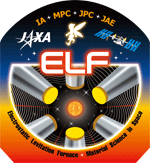*BOV :Balloon-based Operation Vehicle
Microgravity experiment system using high altitude balloon(BOV :Balloon-based Operation Vehicle)
In order to fulfill the gap between short-term microgravity experiment system (parabolic flight and drop tower) and long-term one (the International Space Station) , a new system using a high altitude balloon (BOV :Balloon-based Operation Vehicle) has been developed.
A combustion experiment (Combustion of Japanese sparker in microgravity) was conducted in the second flight of BOV in May, 2007.

High altitude balloon
 In order to get low gravity condition (10-4G) around 30 seconds, free fall from as high as 40Km above sea level was required. To reach such a high altitude, a high altitude balloon was utilized. Helium gas was filled in the balloon, and altitude of the balloon was controlled using gas exhaust mechanism and ballast release system.
In order to get low gravity condition (10-4G) around 30 seconds, free fall from as high as 40Km above sea level was required. To reach such a high altitude, a high altitude balloon was utilized. Helium gas was filled in the balloon, and altitude of the balloon was controlled using gas exhaust mechanism and ballast release system.
The balloon flew east by eastbound wind while the balloon was in low altitude, and return west by westbound wind in high altitude. When the balloon reached the pre-determined position, a free fall capsule (BOV) was released from the balloon.

balloon launch →ballast→microgravity experiment→retrievel
Details of the microgravity experiment section in BOV
In order to get better gravity level, the microgravity experiment section is levitating inside the BOV. Therefore, the experiment section has to contain its own power supply, control system, etc. Command and telemetry from/to ground should be transferred wirelessly, via BOV. Every component of the experiment system was packed in the sphere whose diameter was 28 cm.




